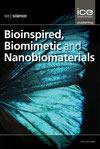刺五加提取物壳聚糖包被脂质体的合成、分析及抗肺炎球菌效力
IF 0.6
4区 工程技术
Q4 ENGINEERING, BIOMEDICAL
引用次数: 0
摘要
在本研究中,制备了壳聚糖(CS)包被脂质体(lipcsp -壳聚糖)纳米载体,用于递送棘叶多糖(CsP)多酚,以提高其生物利用度和抗肺炎链球菌的潜力。采用离子胶凝法合成了lipcsp -壳聚糖,并利用Malvern zetasizer和傅里叶变换红外(FTIR)对其进行了表征;研究了CsP的包封和释放动力学。通过琼脂孔扩散和微稀释试验获得纳米制剂的抗肺炎球菌活性。lipcsp -壳聚糖的水动力尺寸为365.22±0.70 nm, zeta电位为+39.30±0.61 mV。CsP包封率为81.5%。FTIR分析显示脂质体与壳聚糖和CsP的相互作用。观察到两相CsP释放概况,随后是持续释放模式。lipcsp -壳聚糖在模拟胃期对多酚的生物可及性(74.1%±1.3)高于模拟肠期(63.32%±1.00)。与CsP相比,lipcsp -壳聚糖的相对抑制带直径为84.33%±2.51。在最低抑制浓度为31.25 mg/mL时,24 h后,lipcsp -壳聚糖对肺炎克雷伯菌的抑制率为57.45%±3.76。本研究的结果为利用lipcsp -壳聚糖作为候选抗肺炎球菌药物的纳米载体提供了新的途径。本文章由计算机程序翻译,如有差异,请以英文原文为准。
Chitosan-coated liposomes of Carrisa spinarum extract: synthesis, analysis and anti-pneumococcal potency
In the present study, a chitosan (CS)-coated liposome (LipCsP-Chitosan) nanocarrier was fabricated for the delivery of Carissa spinarum (CsP) polyphenols to improve bioavailability and anti-pneumococcal potential against Klebsiella pneumoniae. LipCsP-Chitosan was synthesized by the ion gelation method and characterized by using a Malvern zetasizer and Fourier Transform Infrared (FTIR); CsP encapsulation and release kinetics were investigated. Anti-pneumococcal activity of the nanoformulations was accessed by agar-well diffusion and microdilution assays. LipCsP-chitosan exhibited a hydrodynamic size and zeta potential of 365.22 ± 0.70 nm and +39.30 ± 0.61 mV, respectively. CsP had an encapsulation efficiency of 81.5%. FTIR analysis revealed the interaction of the liposomes with chitosan and the CsP. A biphasic CsP release profile followed by a sustained release pattern was observed. LiPCsP-Chitosan presented a higher bioaccessibility of polyphenols in the simulated gastric phase (74.1% ± 1.3) than in the simulated intestinal phase (63.32% ± 1.00). LipCsP-chitosan had a relative inhibition zone diameter of 84.33% ± 2.51 when compared to CsP. At minimum inhibition concentration of 31.25 mg/mL, LipCsP-Chitosan reduced the viability of Klebsiella pneumoniae by 57.45% ± 3.76 after 24 h. The results obtained from the current study offer a new approach to the utilization of LipCsP-Chitosan as nanocarriers for candidate anti-pneumococcal agents.
求助全文
通过发布文献求助,成功后即可免费获取论文全文。
去求助
来源期刊

Bioinspired Biomimetic and Nanobiomaterials
ENGINEERING, BIOMEDICAL-MATERIALS SCIENCE, BIOMATERIALS
CiteScore
2.20
自引率
0.00%
发文量
12
期刊介绍:
Bioinspired, biomimetic and nanobiomaterials are emerging as the most promising area of research within the area of biological materials science and engineering. The technological significance of this area is immense for applications as diverse as tissue engineering and drug delivery biosystems to biomimicked sensors and optical devices.
Bioinspired, Biomimetic and Nanobiomaterials provides a unique scholarly forum for discussion and reporting of structure sensitive functional properties of nature inspired materials.
 求助内容:
求助内容: 应助结果提醒方式:
应助结果提醒方式:


